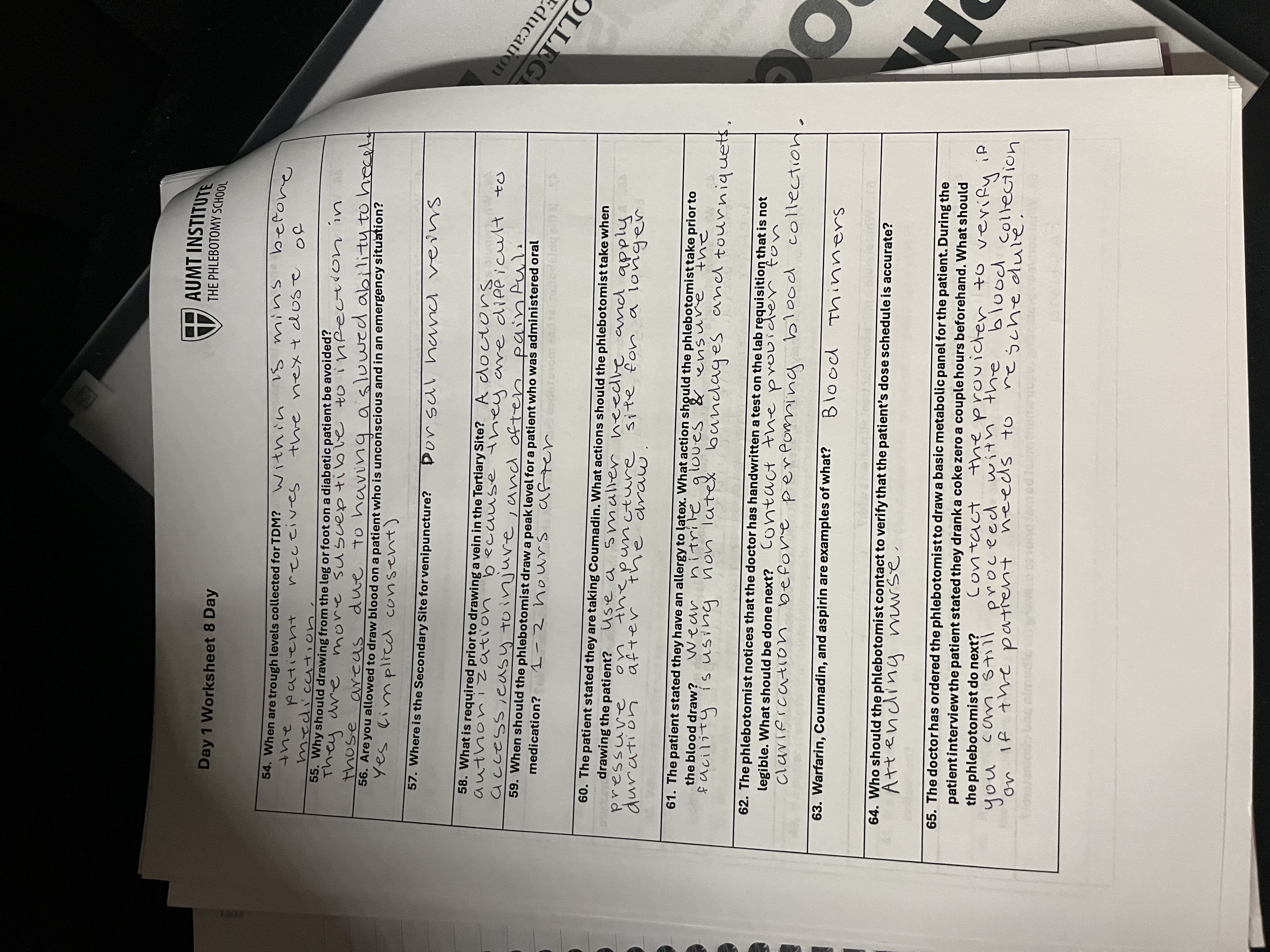Phlebotomy exam 1 - Flashcards (AUMT Institute)
1/50
Earn XP
Description and Tags
A comprehensive set of QA-style Q&A flashcards derived from Day 1 Worksheet 8 notes to practice for the exam.
Name | Mastery | Learn | Test | Matching | Spaced |
|---|
No study sessions yet.
51 Terms
What tube is used for STAT chemistry tests and how long should this tube clot for?
Orange (RST) tube; it should clot for 5 minutes.
What is an anticoagulant?
An additive that prevents the blood from clotting.
Hematology tests are done in what color tube?
Lavender.
What should be done if a patient is in shock?
Maintain an open airway, control bleeding, and keep the patient warm until help arrives.
How many minutes should pressure be applied if an artery is accidentally punctured?
5 minutes.
What is the 3rd IV Rule?
Turn off the IV for 2 minutes, then draw.
A patient who has a history of syncope should be placed in what position for a blood draw?
Supine (lying on the back).
Which tube is used for coagulation testing?
Light Blue (sodium citrate).
Which tube is referred to as an RST tube?
Orange.
Which tube can contain either a clot activator or EDTA?
Royal Blue.
When an ETS serum tube contains gel separator, what is it called?
SST Serum Separator Tube (Serum Separator Tube).
What is a desirable trait of a phlebotomist?
Demonstrating respect, good service, and growth.
Phlebotomists are responsible for ensuring what aspects of specimen collection?
Reliability, accuracy and precision.
A blood pressure cuff can be pumped up to what pressure to function as a tourniquet?
40 mm Hg.
What does the PST stand for in tubes?
Plasma Separator Tube.
What is the syringe method used for?
Used on patients with fragile, collapsing veins.
Before removing the cap of a needle, what should a phlebotomist inspect?
Expiration date, label/seal intact, tampering, and safety device.
The winged infusion device is used for what kind of veins?
Small, rolling veins.
What does the date on a needle refer to?
Sterility of the needle.
What are the main veins in the antecubital area?
Median cubital, cephalic, and basilic.
When cleansing the venipuncture site, what motion should be used?
Back and forth.
What angle should the needle be at for a venipuncture?
15-30 degrees.
How many times should you invert the vacutainer?
8-10x.
When can a patient’s emotional state affect the chances of syncope?
Before and after a blood draw.
List some complications that can occur during or after venipuncture?
Hematoma, nerve damage, shock, nausea.
What antiseptic solution should be used for a patient with an allergy to alcohol?
Chlorhexidine.
Name 3 tests that can be performed on a lavender top tube.
CBC, Hemoglobin A1C, ESR.
What are the two additives in the gray top tube?
Sodium fluoride and potassium oxalate.
Which serum tube does not contain a gel barrier?
Red.
What can lead to a misdiagnosis or an incorrect treatment plan?
Patient’s name and date of birth (identifying information).
A laboratory order (requisition) form should include?
Gender, MRN, and doctor's information.
When should a phlebotomist label a patient’s blood collection tubes?
After the draw.
Before performing any procedure, The Joint Commission mandates using how many identifiers to verify a patient's identity?
Two identifiers.
What agency has guidelines which mandate maintaining the patient's privacy and confidentiality?
HIPAA.
What are the different types of consent?
Informed, expressed, implied, and consent for minors.
What are the most common pretesting preparations a provider can give a patient?
Fasting, medication, and basal state.
If a patient feels faint or faints (syncope) how long must the phlebotomist observe the patient following this episode?
15 minutes.
If a patient has exercised before having their blood drawn how long must they wait before blood collection?
15 to 30 minutes.
If a patient informs the phlebotomist that they are experiencing severe pain, numbness or tingling in the venipuncture arm, this can be a sign of what?
Nerve damage.
These veins should be the last choice for a venipuncture?
Basilic vein.
What is the purpose of palpating a vein?
To determine its depth, direction and dimension.
What would a vein that is tender and warm to the touch with a red area around it be called?
Phlebitic veins.
What would a vein that is thin, weak, and difficult to puncture be called?
Fragile veins.
What should be placed on the puncture site to avoid post-puncture bleeding?
Pressure with a gauze pad.
What steps should a phlebotomist use if there is missing information on a requisition form?
Contact the provider for clarification before performing the blood collection.
What should a phlebotomist treat all patients with?
Respect.
If a patient extends their arm for venipuncture, what type of consent is this?
Implied consent.
What common pretesting requirement must be met prior to drawing for albumin and cholesterol?
Fasting.
